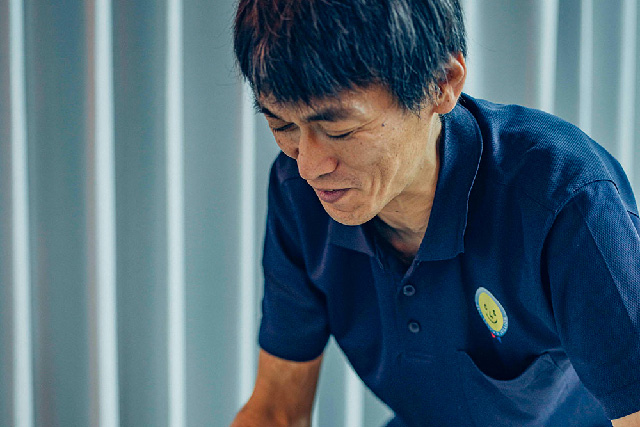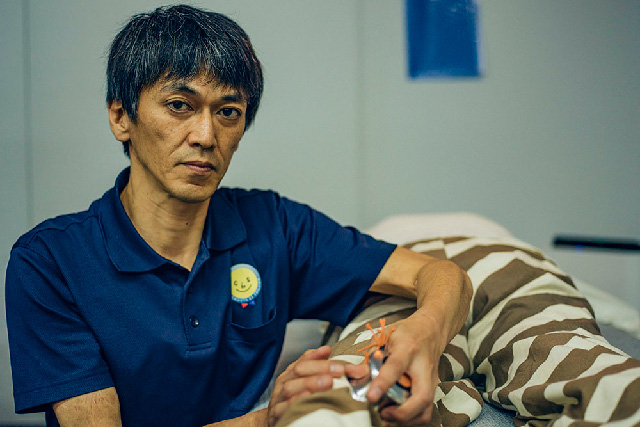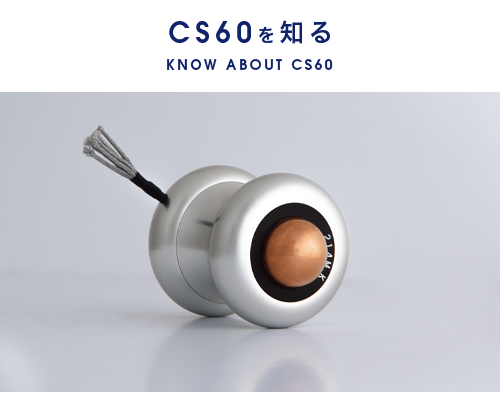
- 2019/09/19
-
Newsletter Vol.24
CS60施術者 那須 仁さんインタビュー(後編)
Interview with CS60 Practitioner Jin Nasu Part II
Praticien du CS60 : l’interview de Monsieur Jin Nasu (dernière partie) 
CS60には多くの人が関わっています。それぞれどんな想いで、施術を行っているのでしょうか。
それを知るために、「CS60に関わる人たち」のインタビューを行うことにしました。
今回は、本部で働く那須 仁さんにお話をうかがいます。
――――――――――――――――――――――――――CS60のことを知らない方にどのように説明していますか?
那須:いろいろ試した結果、わかりやすい説明で終わらせないとドツボにハマることがわかったので(笑)。友達には「細胞の掃除機があるよ。体が変わって気持ちがいいよ」というふうに言っています。
―CS60の施術をしていて、面白いことはありますか。
那須:ある日気づいたのが、「楽器と同じ」ということです。
楽器は音を出して、波動を相手に伝えますよね。
イライラしていたらイライラする波動が出てしまいます。
CS60もそれと同じで、持ち手の気持ちがすごく大事です。
受ける側も施術する側も、お互い波動を出しながらセッションしている感じがあります。―どんな感じでセッションしているのですか。
那須:相手のことを感じとりながら、スピードや圧のかけ方などを変えていきます。
―何も考えずにさするわけではないのですね。
那須:会員さんが今どういう状態なのか、最初の会話やファーストタッチの瞬間に感じとるように意識しています。
「ここをやると気持ちがいいだろうな」という感覚でスタートすることもあるけど、そうすると相手からの反応がパッと出てきますので、「今日はこんな感じなのか」という察しがつきます。
それから施術に入るという段取りを踏んでいます。
相手との呼吸がフィットする瞬間が多ければ多いほど、細胞から悪いものが抜ける量も回数も増えてきます。
うまくフィットしないとギクシャクしてしまいます。
同じ方でも、日によって体調が変わるので対応を変えています。
CS60は自分にとって、会員さんとコミュニケーションさせていただくツールなのです。
―これからCS60を始めたいという方にメッセージをお願いします。
那須:CS60は、年齢や学歴、職歴、何も関係なく取り組めるものです。
万人ができるすばらしさを感じています。
最近西村先生が世界中に行って施術していることで、人種も関係なく使ってもらえることがわかりました。
新しく入ってくる方は、研修で基本の使い方やコツを学んで、それぞれ自分らしいやり方を見つけてほしいなと思います。
どんどん施術しているうちに、新しい発見があったり、感動したりする出会いがあるはずです。
それを積み重ねていけば、CS60から広がるすてきなことに出会えます。
先生もいまだに発見の連続だと言っていました。
いろいろなアプローチの仕方もあるし、大勢に会えば会うほど気づきがあります。
みなさんも自分の好きなスタイルを軸に持つと、面白いことが延々と続くと思いますよ。(おわり)
There are many different people involved with the CS60. But what is it that is going in their heads that is motivating their practice?
We decided to conduct interviews with the people involved in CS60, because we wanted to know the answer to this question.
On this occasion, we came to talk to Jin Nasu at the CS60 HQ.―――――――――――――――――――――――――
― How do you explain the CS60 to people who don’t know what it is?
Nasu: Well, I’ve tried a lot of different things, and as a result, one thing I have learned for sure is that if you don’t finish explaining quickly and simply, you’re going to get stuck in the mud! I just tell my friends that it’s like a vacuum cleaner for your cells, and that it makes you feel like you have a whole new body.
― Have you had any interesting experiences in performing the CS60 treatment?
Nasu: One day I had this realization that the CS60 is just like a musical instrument! A musical instrument creates sound, which transmits waves to the people listening. If you play angrily, you transmit angry waves. The practitioner’s feelings are important in the same way when using the CS60. It’s kind of like the practitioner and the patient are both jamming and transmitting waves to each other.
― What do you mean by it being like jamming?
Nasu: Well, you sort of need to read the other person and adjust your own speed and pressure to them.
― So, you can’t just rub the CS60 on someone without thinking?
Nasu: I try to be conscious of figuring out what state the member is in, based on the first conversation or first touch I have with them.
Sometimes when you start out people have a sense of “if you did it here, I think it would feel good,” and so you get a reaction immediately from the other person, and you can sort of guess that you should do it this way or that way on that day.
From there you work out a plan for the treatment. The more you can fit in with the other person’s breathing, the more times and the greater amount of toxins you will be able to remove from their cells. If you can’t get that fit right, it becomes awkward. Even treating the same person, their condition can be totally different depending on the day, so you have to adjust.
For me, the CS60 is kind of a like a tool for communicating with members.― Do you have a message for people who want to start with the CS60?
Nasu: The CS60 is something you can do regardless of your age, education, or professional experience. I think it’s wonderful that anyone can do it.
Recently Dr. Nishimura has been traveling the world treating people, so it has become clear that you can even use it regardless of race.
People who are newly joining should go to training to learn the basics of how to use the CS60, and once they get the hang of it, find a way of using it that suits them, I think. As you continue using the CS60, you will discover new things, and have new encounters that will really move you.
The more of those experiences you have, the more you will encounter the wonderful things that emanate from the CS60. Even Dr. Nishimura says that he is discovering new things through it to this day.
There are all kinds of different approaches and ways of using the CS60, so I think there are a lot of things to learn from meeting more and more people with it. I think everyone should find their own preferred style, and, through it, continuously find and new interesting experiences.(End)
De nombreuses personnes sont concernées par le CS60. Dans quel but l’utilisent-elles ? Afin d’en savoir plus, nous avons interrogé ces « personnes concernées par le CS60 ».
Cette fois-ci, nous avons interviewé Monsieur Jin Nasu qui travaille au siège du CS60.―――――――――――――――――――――――――
– Comment expliquez-vous le CS60 aux gens qui ne le connaissent pas ?
Nasu : Après avoir essayé plusieurs façons, j’ai bien compris que les gens ne comprenaient pas le CS60 lorsque je leur expliquais en détails (lol). Lorsque j’invite des amis à une séance de CS60, je leur explique que c’est un aspirateur qui agit au sein des cellules et qu’il leur fera du bien en agissant sur le corps.
– Avez-vous trouvé quelque chose d’intéressant dans les soins du CS60 ?
Nasu : L’autre jour, je me suis rendu compte que le CS60 était identique aux instruments de musique.
Les instruments de musique transmettent des ondes aux gens en émettant un son.
Lorsque vous êtes agacé et que vous utilisez un instrument, vous émettez des ondes irritantes.
C’est le cas aussi pour le CS60. Le sentiment du praticien se ressent beaucoup.
J’ai l’impression que celui qui reçoit un soin et celui qui le donne émettent l’un et l’autre des ondes pendant la session.– Comment soignez-vous les gens pendant les soins ?
Nasu : En fonction de la condition du patient, je change la vitesse et la façon d’appliquer le CS60 sur le corps.
– Vous ne frottez pas le corps du patient sans penser à rien donc.
Nasu : J’essaie de ressentir la condition du patient lorsque je parle pour la première fois avec lui ou lorsque je touche son corps pour la première fois.
Avant de commencer une session, je pense de temps en temps que je peux faire du bien au patient si je frotte une partie spécifique. Le patient réagit très rapidement et je peux ainsi deviner sa condition.
Puis, je commence le soin.
Plus le patient et moi réussissons à nous accorder, plus les choses mauvaises sortent des cellules.
Si nous n’arrivons pas à bien nous accorder, nous resterons mal à l’aise pendant la session.
La condition physique d’une personne varie selon les jours, c’est pourquoi je soigne la même personne de différentes manières.
Le CS60 est un outil qui me permet d’établir un dialogue avec mes patients.– Pourrez-vous donner un message à ceux qui veulent s’initier au CS60, s’il vous plaît ?
Nasu : Tout le monde peut pratiquer le CS60 indépendamment de l’âge, du parcours scolaire ou de l’expérience professionnelle.
Je trouve ça magnifique.
Grâce au fait que le professeur Nishimura voyage dans le monde entier pour soigner les gens ces derniers temps, nous constatons que nous pouvons utiliser le CS60 pour soigner différents peuples.
Pour ceux qui commencent à pratiquer le CS60, j’espère qu’ils apprendront la base et qu’ils réussiront à trouver leur propre façon de faire.
Plus ils donneront de soins, plus ils feront des découvertes et des rencontres émouvantes.
Après avoir acquis une certaine expérience, ils découvriront des choses merveilleuses au travers du CS60.
Le professeur Nishimura lui-même fait encore de nombreuses découvertes.
Il existe différentes manières et approches de travail. Plus on rencontre de gens, plus on apprend.
Lorsque vous trouverez votre style, votre activité deviendra de plus en plus intéressante.(Fin)
INDEX
















